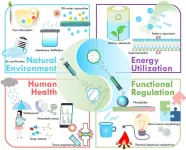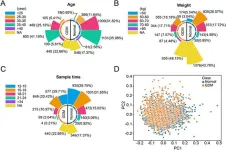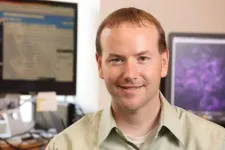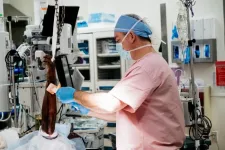(Press-News.org) Combining these two twins-tech, electrospinning and electrospraying, to fabricate novel nanomaterials is an urgent area of research for materials scientists and biomedical engineers, according to a new paper by Professor Hu Jinlian of City University of Hong Kong (CityUHK) published in Matter, a highly respected monthly journal encompassing materials science, from nano to macro, and from fundamentals to application.
The electrospinning and electrospraying synergism (ESS) can positively impact diverse sectors, from bioengineering and textile technology to medical treatment, defence technology, intelligent manufacturing to energy conversion, argues Professor Hu, who researches electrospinning, electrospraying, nanofibres, nanomaterials, human health and functional membranes.
“This highly integrated ESS technology has received great attention from scientists in the last decade, but we are now facing a critical bottleneck period and seeing hidden problems because of rapid development over the past decade,” explains Professor Hu, who is the Director of the Laboratory of Wearable Materials for Healthcare and holds a joint appointment in CityUHK’s Department of Materials Science and Engineering and Department of Biomedical Engineering.
EES technology has incomparable advantages over other micro-nano material preparation technologies. It offers to reduce the steps needed in micro-nano material preparation technologies, such as 3D printing, lithography, or other chemical methods; it provides outstanding controllability of diameter, orientation, morphology, density, pore size, and chemical properties of nanofibers; and realizes the perfect combination of 1D fibre and 0D/3D micro-nano particles.
However, the challenges are many. They include a need for more systematic generalization, summary and classification, and the disconnection between the research community and the industry. Hu argues that the focus of ongoing research into combining electrospinning and electrospraying mechanisms tends to avoid the issue of the synergy of the two processes and instead highlights the two separate technologies, glossing over the advantages that can be captured by the possible coordination and cooperation between the two.
“If the concept of EES technology can be generalized, it will undoubtedly give scientists new ideas and inspire many studies. In turn, it can also vigorously promote the iteration and upgrade of EES technology,” Professor Hu argues.
The Matter paper "Electrospinning and electrospraying synergism: Twins-tech collaboration across dimensions" explains that electrospraying and electrospinning are fundamentally similar processes. However, there are differences.
“E-spinning technology is often used as the construction method of the main structure. It should be noted that e-spinning technology can sometimes be used for surface modification or regulation purposes. E-spraying technology is generally used as the control or modification means of material properties,” Professor Hu says.
So, what will EES create in the future?
First, EES technology will significantly enrich the preparation of micro-nano composite materials. It will be possible to prepare complex structures that are difficult to obtain by traditional chemical methods, which is essential in catalysis, drug loading and biological detection.
Second, the EES technology will revolutionize the field of functional apparel. Giving apparel special functions, such as waterproofing, cooling/warming, anti-ultraviolet, health detection, etc., will become a trend of commodity development.
Additionally, industrial assembly lines of EES equipment will enter the factory and complete supply chains, while sales channels will gradually appear.
Using the two processes together rather than separately, researchers can contribute to several fields, for example, in the natural environment field, through purification, recovery, and reuse of water resources using porous membrane materials.
In addition to purifying polluted water, nanofibre membranes based on the EES strategy can be used for water harvesting, directly converting water vapour from the environment into clean water. Applications of EES in energy utilization, human health, and functional membranes are also possible.
“EES technology has become an important means of preparing micro-nanoscale composite functional materials over the past 20 years. This is a critical period for its ability to overcome major challenges and move toward future success. We should have an open, enterprising, and innovative mentality to promote the next round of the EES technological revolution,” Professor Hu concludes.
END
A positive spin—electrospinning and electrospraying synergism for the nanomaterials industry
Electrospinning and electrospraying for fabricating novel nanomaterials is an urgent area of research for materials scientists and biomedical engineers
2024-02-01
ELSE PRESS RELEASES FROM THIS DATE:
cfDNA sequencing enhances non-invasive early detection of gestational diabetes
2024-02-01
Gestational diabetes mellitus (GDM) is a prevalent pregnancy complication posing significant health risks to both mothers and their newborns. Early detection and treatment of GDM are crucial to prevent adverse outcomes. Current screening methods, like glucose tolerance tests, are in after 24 weeks of pregnancy and have limitations in patient compliance and accuracy.
A new study led by Lijian Zhao, Pei Sun, Hui Huang, Nan Li at BGI Genomics in collaboration with the Beijing Obstetrics and Gynecology Hospital, recently published on Briefings in Bioinformatics ...
Promising heart drugs ID'd by cutting-edge combo of machine learning, human learning
2024-02-01
University of Virginia scientists have developed a new approach to machine learning – a form of artificial intelligence – to identify drugs that help minimize harmful scarring after a heart attack or other injuries.
The new machine-learning tool has already found a promising candidate to help prevent harmful heart scarring in a way distinct from previous drugs. The UVA researchers say their cutting-edge computer model has the potential to predict and explain the effects of drugs for other diseases as well.
“Many common diseases such as heart disease, ...
Large multicenter clinical trial finds that antiseptic containing iodine reduces surgical-site infections in patients with extremity fractures
2024-02-01
A large multicenter clinical trial co-led by University of Maryland School of Medicine researchers large multicenter clinical trial co-led by University of Maryland School of Medicine researchers found that an antiseptic containing iodine resulted in about one-quarter fewer post-surgical infections in patients with limb fractures compared to another frequently used skin antiseptic. The results of the study of nearly 8,500 patients across the United States and Canada were published today in the New England Journal of Medicine.
The study – which compared the ...
Jealousy – we understand our own sex best
2024-02-01
We may not always fully understand why our partners get jealous, and women and men often get jealous for completely different reasons.
Two researchers from the Norwegian University of Science and Technology (NTNU) decided to investigate whether people also know about these distinct differences between the sexes.
“What do people think triggers women’s and men’s jealousy? How well do women understand men’s jealousy, and men women’s jealousy? We wanted to find out,” says Professor Mons Bendixen at the Department of Psychology.
Men are more jealous ...
Hiring the most qualified candidate might be unfair
2024-02-01
WASHINGTON — Both liberals and conservatives are more likely to believe that merit-based hiring is unfair after learning about the impacts of socioeconomic disparities, according to a study published by the American Psychological Association.
People from across the political spectrum also are more likely to support programs that encourage socioeconomic diversity after learning about the effects of social class and low income, according to the research, published online in the Journal of Experimental Psychology: General.
“Socioeconomic disadvantages early in life can undermine educational achievement, ...
Excavation of colossal caverns for Fermilab’s DUNE experiment completed
2024-02-01
Excavation workers have finished carving out the future home of the gigantic particle detectors for the international Deep Underground Neutrino Experiment. Located a mile below the surface, the three colossal caverns are at the core of a new research facility that spans an underground area about the size of eight soccer fields.
Hosted by the U.S. Department of Energy’s Fermi National Accelerator Laboratory, DUNE scientists will study the behavior of mysterious particles known as neutrinos to solve some of the biggest questions about our universe. Why is our ...
BIPOC individuals bear greater post-COVID health burdens, new research suggests
2024-02-01
Black, indigenous, and people of color (BIPOC) who were infected with COVID-19 experienced greater negative aftereffects in health and work loss than did similarly infected white participants, new research finds.
Despite similar symptom prevalence, BIPOC and Hispanic patients experienced greater negative impacts on their health status, activity levels, and ability to work compared with non-Hispanic and white patients participating in the ongoing multi-site INSPIRE clinical trial examining people with long COVID.
The findings are published in the journal Frontiers ...
National Academy of Medicine member new president of The Obesity Society
2024-02-01
ROCKVILLE, Md. — A member of the National Academy of Medicine is the new president of The Obesity Society (TOS), the organization announced today.
Jamy Ard, MD, FTOS, is professor in the Departments of Epidemiology and Prevention and Internal Medicine and vice dean of Clinical Research at Wake Forest University School of Medicine in Winston-Salem, N.C. He also co-directs the Atrium Health Wake Forest Baptist Weight Management Center, where he oversees medical weight management programs.
“I am honored to serve as president of ...
How to run a password update campaign efficiently and with minimal IT costs
2024-02-01
Updating passwords for all users of a company or institution’s internal computer systems is stressful and disruptive to both users and IT professionals. Many studies have looked at user struggles and password best practices. But very little research has been done to determine how a password update campaign can be conducted most efficiently and with minimal IT costs. Until now.
A team of computer scientists at the University of California San Diego partnered with the campus’ Information Technology Services to analyze the messaging for a campuswide mandatory ...
Five advances that could change heart health monitoring
2024-02-01
Chocolate valentines and candies with sweet sayings shouldn't be the only hearts you think about this February. It’s also American Heart Month, which puts a spotlight on cardiovascular health. According to the American Heart Association, heart disease is the leading cause of death for Americans, so it’s important to know the status of your own heart health. New methods for cardiac monitoring can be found in these five papers recently published in ACS journals. Reporters can request free access to these papers by emailing newsroom@acs.org.
Future ...
LAST 30 PRESS RELEASES:
Heart-brain connection: international study reveals the role of the vagus nerve in keeping the heart young
Researchers identify Rb1 as a predictive biomarker for a new therapeutic strategy in some breast cancers
Survey reveals ethical gaps slowing AI adoption in pediatric surgery
Stimulant ADHD medications work differently than thought
AI overestimates how smart people are, according to HSE economists
HSE researchers create genome-wide map of quadruplexes
Scientists boost cell "powerhouses" to burn more calories
Automatic label checking: The missing step in making reliable medical AI
Low daily alcohol intake linked to 50% heightened mouth cancer risk in India
American Meteorological Society announces Rick Spinrad as 2026 President-Elect
Biomass-based carbon capture spotlighted in newly released global climate webinar recording
Illuminating invisible nano pollutants: advanced bioimaging tracks the full journey of emerging nanoscale contaminants in living systems
How does age affect recovery from spinal cord injury?
Novel AI tool offers prognosis for patients with head and neck cancer
Fathers’ microplastic exposure tied to their children’s metabolic problems
Research validates laboratory model for studying high-grade serous ovarian cancer
SIR 2026 delivers transformative breakthroughs in minimally invasive medicine to improve patient care
Stem Cell Reports most downloaded papers of 2025 highlight the breadth and impact of stem cell research
Oxford-led study estimates NHS spends around 3% of its primary and secondary care budget on the health impacts of heat and cold in England
A researcher’s long quest leads to a smart composite breakthrough
Urban wild bees act as “microbial sensors” of city health.
New study finds where you live affects recovery after a hip fracture
Forecasting the impact of fully automated vehicle adoption on US road traffic injuries
Alcohol-related hospitalizations from 2016 to 2022
Semaglutide and hospitalizations in patients with obesity and established cardiovascular disease
Researchers ‘listen in’ to embryo-mother interactions during implantation using a culture system replicating the womb lining
How changing your diet could help save the world
How to make AI truly scalable and reliable for real-time traffic assignment?
Beyond fragmented markets: A new framework for efficient and stable ride-pooling
Can shape priors make road perception more reliable for autonomous driving?
[Press-News.org] A positive spin—electrospinning and electrospraying synergism for the nanomaterials industryElectrospinning and electrospraying for fabricating novel nanomaterials is an urgent area of research for materials scientists and biomedical engineers




